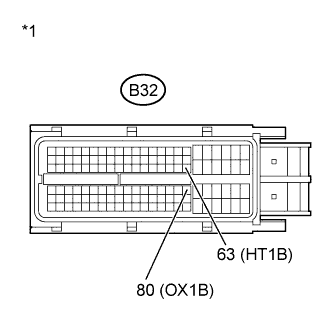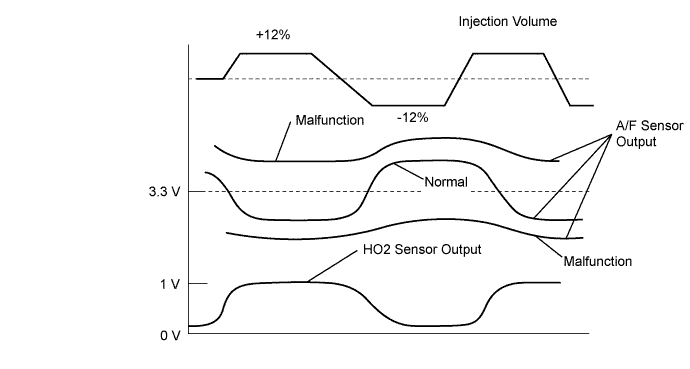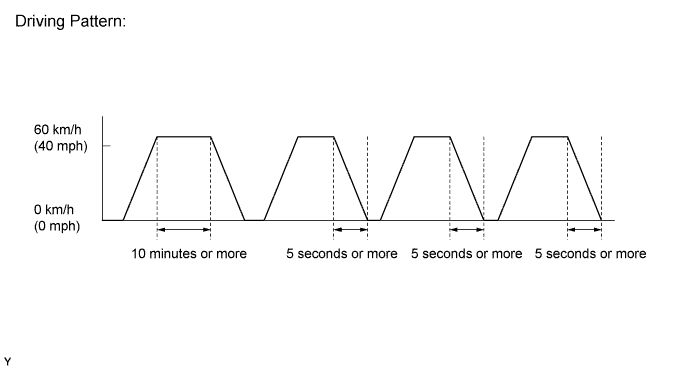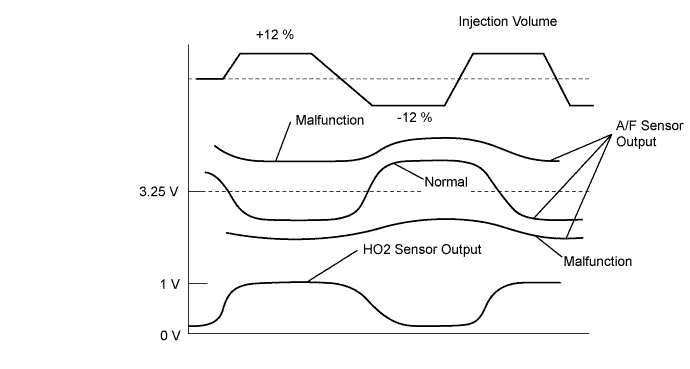READ OUTPUT DTC (DTC P0136, P0137 OR P0138)
READ VALUE USING INTELLIGENT TESTER (OUTPUT VOLTAGE OF HEATED OXYGEN SENSOR)
INSPECT HEATED OXYGEN SENSOR (CHECK FOR SHORT)
CHECK HARNESS AND CONNECTOR (CHECK FOR SHORT)
PERFORM ACTIVE TEST USING INTELLIGENT TESTER (INJECTION VOLUME)
READ VALUE USING INTELLIGENT TESTER (OUTPUT VOLTAGE OF HEATED OXYGEN SENSOR)
PERFORM ACTIVE TEST USING INTELLIGENT TESTER (INJECTION VOLUME)
INSPECT HEATED OXYGEN SENSOR (HEATER RESISTANCE)
CHECK HARNESS AND CONNECTOR (HEATED OXYGEN SENSOR - ECM)
PERFORM CONFIRMATION DRIVING PATTERN
CHECK WHETHER DTC OUTPUT RECURS (DTC P0136, P0137 OR P0138)
PERFORM CONFIRMATION DRIVING PATTERN
CHECK WHETHER DTC OUTPUT RECURS (DTC P0136 OR P0138)
DTC P0136 Oxygen Sensor Circuit Malfunction (Bank 1 Sensor 2) |
DTC P0137 Oxygen Sensor Circuit Low Voltage (Bank 1 Sensor 2) |
DTC P0138 Oxygen Sensor Circuit High Voltage (Bank 1 Sensor 2) |
DESCRIPTION
- HINT:
- Sensor 2 refers to the sensor mounted behind the three way catalytic converter and located far from the engine assembly.
The heated oxygen sensor is located behind the three way catalytic converter, and detects the oxygen concentration in the exhaust gas. Since the sensor is integrated with the heater that heats the sensing portion, it is possible to detect the oxygen concentration even when the intake air volume is low (the exhaust gas temperature is low).
When the air fuel ratio becomes lean, the oxygen concentration in the exhaust gas is rich. The heated oxygen sensor informs the ECM that the post three way catalytic converter air fuel ratio is lean (low voltage, i.e. below 0.45 V).
Conversely, when the air fuel ratio is richer than the stoichiometric air fuel level, the oxygen concentration in the exhaust gas becomes lean. The heated oxygen sensor informs the ECM that the post three way catalytic converter air fuel ratio is rich (high voltage, i.e. higher than 0.45 V). The heated oxygen sensor has the property of changing its output voltage drastically when the air fuel ratio is close to the stoichiometric level.
The ECM uses the supplementary information from the heated oxygen sensor to determine whether the air fuel ratio after the three way catalytic converter is rich or lean, and adjusts the fuel injection time accordingly. Thus, if the heated oxygen sensor is working improperly due to internal malfunctions, the ECM is unable to compensate for deviations in the primary air fuel ratio control.

| DTC No. | DTC Detection Condition | Trouble Area |
| P0136 |
|
|
| P0137 |
|
|
| P0138 |
|
|
WIRING DIAGRAM
Refer to DTC P2195 (RAV4_ACA30 RM000000WC40H8X_07.html).CONFIRMATION DRIVING PATTERN
- HINT:
- This confirmation driving pattern is used in the "Perform Confirmation Driving Pattern" procedure of the following diagnostic troubleshooting procedure.
- Performing this confirmation driving pattern will activate the heated oxygen sensor monitor (the catalyst monitor is performed simultaneously). This is very useful for verifying the completion of the repair.

- Connect the intelligent tester to the DLC3.
- Turn the ignition switch to ON.
- Turn the tester on.
- Enter the following menus: Powertrain / Engine and ECT / DTC / Clear.
- Clear the DTCs.
- Start the engine and warm it up (Procedure "A").
- Drive the vehicle at between 90 km/h and 110 km/h (56 mph and 68 mph) for at least 10 minutes (Procedure "B").
- Enter the following menus: Powertrain / Engine and ECT / Utility / All Readiness.
- Input DTCs: P0136, P0137 and P0138.
- Check that DTC MONITOR is NORMAL. If DTC MONITOR is INCOMPLETE, perform the driving pattern by accelerating the vehicle to a higher speed and using second gear to decelerate the vehicle.
INSPECTION PROCEDURE
- HINT:
- Malfunctioning areas can be identified by performing the Control the Injection Volume for A/F sensor function provided in the Active Test. The Control the Injection Volume for A/F sensor function can help to determine whether the Air Fuel Ratio (A/F) sensor, Heated Oxygen (HO2) sensor and other potential trouble areas are malfunctioning.
- The following instructions describe how to conduct the Control the Injection Volume for A/F sensor operation using the intelligent tester.
- Connect the intelligent tester to the DLC3.
- Start the engine and turn the tester on.
- Warm up the engine at an engine speed of 2500 rpm for approximately 90 seconds.
- Enter the following menus: Powertrain / Engine and ECT / Active Test / Control the Injection Volume for A/F sensor.
- Perform the Active Test operation with the engine idling (press the RIGHT or LEFT button to change the fuel injection volume).
- Monitor the output voltages of the A/F and HO2 sensors (AFS Voltage B1 S1 and O2S B1 S2) displayed on the tester.
- HINT:
- The Control the Injection Volume for A/F sensor operation decreases the fuel injection volume by 12.5% or increases the injection volume by 25%.
- Each sensor reacts in accordance with increases and decreases in the fuel injection volume.
| Tester Display (Sensor) | Injection Volume | Status | Voltage |
| AFS Voltage B1 S1 (A/F) | +25% | Rich | Below 3.1 V |
| AFS Voltage B1 S1 (A/F) | -12.5% | Lean | Higher than 3.4 V |
| O2S B1 S2 (HO2) | +25% | Rich | Higher than 0.55 V |
| O2S B1 S2 (HO2) | -12.5% | Lean | Below 0.4 V |
- NOTICE:
- The air fuel ratio sensor has an output delay of a few seconds and the heated oxygen sensor has a maximum output delay of approximately 20 seconds.
| Case | A/F Sensor (Sensor 1) Output Voltage | HO2 Sensor (Sensor 2) Output Voltage | Main Suspected Trouble Area |
| 1 |   |   | - |
| 2 |   |   |
|
| 3 |   |   |
|
| 4 |   |   |
|
- Following the Control the Injection Volume for A/F sensor procedure enables technicians to check and graph the voltage outputs of both the A/F and HO2 sensors.
- To display the graph, enter the following menus: Powertrain / Engine and ECT / Active Test / Control the Injection Volume for A/F Sensor / A/F Control System / AFS Voltage B1 S1 and O2S B1 S2.
- NOTICE:
- Inspect the fuses for circuits related to this system before performing the following inspection procedure.
- HINT:
- Read freeze frame data using the intelligent tester. Freeze frame data records the engine condition when malfunctions are detected. When troubleshooting, freeze frame data can help determine if the vehicle was moving or stationary, if the engine was warmed up or not, if the air fuel ratio was lean or rich, and other data from the time the malfunction occurred.
| 1.READ OUTPUT DTC (DTC P0136, P0137 OR P0138) |
Connect the intelligent tester to the DLC3.
Turn the ignition switch to ON.
Turn the tester on.
Enter the following menus: Powertrain / Engine and ECT / DTC.
Read the DTCs.
Result Result Proceed to DTC P0138 output A DTC P0137 output B DTC P0136 output C
|
| ||||
|
| ||||
| A | |
| 2.READ VALUE USING INTELLIGENT TESTER (OUTPUT VOLTAGE OF HEATED OXYGEN SENSOR) |
Connect the intelligent tester to the DLC3.
Turn the ignition switch to ON.
Turn the tester on.
Enter the following menus: Powertrain / Engine and ECT / Data List / O2S B1 S2.
Allow the engine to idle.
Read the heated oxygen sensor output voltage while idling.
Result Heated Oxygen Sensor Output Voltage Proceed to 1.0 V or higher A Below 1.0 V B
|
| ||||
| A | |
| 3.INSPECT HEATED OXYGEN SENSOR (CHECK FOR SHORT) |
Disconnect the heated oxygen sensor connector.
 |
Measure the resistance according to the value(s) in the table below.
- Standard Resistance:
for LHD Tester Connection Condition Specified Condition 1 (+B) - 4 (OX1B) Always 10 kΩ or higher 1 (+B) - 3 (E2) Always 10 kΩ or higher for RHD Tester Connection Condition Specified Condition 2 (+B) - 3 (OX1B) Always 10 kΩ or higher 2 (+B) - 4 (E2) Always 10 kΩ or higher
Reconnect the heated oxygen sensor connector.
|
| ||||
| OK | |
| 4.CHECK HARNESS AND CONNECTOR (CHECK FOR SHORT) |
Turn the ignition switch off and wait for 5 minutes.
 |
Disconnect the ECM connector.
Measure the resistance according to the value(s) in the table below.
- Standard Resistance:
Tester Connection Condition Specified Condition B32-63 (HT1B) - B32-80 (OX1B) Always 10 kΩ or higher
Text in Illustration *1 Front view of wire harness connector
(to ECM)
Reconnect the ECM connector.
|
| ||||
| OK | ||
| ||
| 5.PERFORM ACTIVE TEST USING INTELLIGENT TESTER (INJECTION VOLUME) |
Connect the intelligent tester to the DLC3.
Start the engine.
Turn the tester on.
Warm up the engine.
Enter the following menus: Powertrain / Engine and ECT / Active Test / Control the Injection Volume.
Change the fuel injection volume using the tester, and monitor the output voltage of the air fuel ratio sensor and heated oxygen sensor displayed on the tester.
- HINT:
- Change the fuel injection volume within the range of -12% and +12%. The injection volume can be changed in 0.2% graduations within this range.
- The air fuel ratio sensor is displayed as AFS Voltage B1 S1, and the heated oxygen sensor is displayed as O2S B1 S2 on the intelligent tester.
Result Tester Display (Sensor) Voltage Variation Proceed to AFS Voltage B1 S1 (A/F) Alternates between higher than and below 3.3 V OK AFS Voltage B1 S1 (A/F) Remains at higher than 3.3 V NG AFS Voltage B1 S1 (A/F) Remains at below 3.3 V NG - HINT:
- A normal heated oxygen sensor voltage (O2S B1 S2) reacts in accordance with increases and decreases in fuel injection volumes. When the air fuel ratio sensor voltage remains at either less or higher than 3.3 V despite the heated oxygen sensor indicating a normal reaction, the air fuel ratio sensor is malfunctioning.

|
| ||||
| OK | |
| 6.INSPECT AIR FUEL RATIO SENSOR |
- HINT:
- This air fuel ratio sensor test is to check the air fuel ratio sensor current during the fuel-cut operation. When the sensor is normal, the sensor current indicates below 3.0 mA in this test.
Connect the intelligent tester to the DLC3.
Turn the ignition switch to ON.
Turn the tester on.
Drive the vehicle according to the driving pattern listed below:
Warm up the engine until the engine coolant temperature reaches 75°C (167°F) or higher.
Drive the vehicle at 60 km/h (40 mph) or more for 10 minutes or more.
Drive the vehicle at 60 km/h (40 mph) or more and decelerate the vehicle for 5 seconds or more.
Repeat the step above at least 3 times.

Enter the following menus: Powertrain / Engine and ECT / Data List / AFS Current B1 S1.
Read the value of the air fuel ratio sensor current while the fuel-cut operation is performing.
- Standard current:
- Below 3.0 mA
- HINT:
- To measure the air fuel ratio sensor current precisely, perform the fuel-cut operation as long as possible.
- If it is difficult to measure the air fuel ratio sensor current, use the snapshot function of the intelligent tester.
|
| ||||
|
| ||||
| 7.READ VALUE USING INTELLIGENT TESTER (OUTPUT VOLTAGE OF HEATED OXYGEN SENSOR) |
Connect the intelligent tester to the DLC3.
Turn the ignition switch to ON.
Turn the tester on.
Start the engine.
Enter the following menus: Powertrain / Engine and ECT / Data List / O2S B1 S2.
After warming up the engine, run the engine at an engine speed of 2500 rpm for 3 minutes.
Read the output voltage of the heated oxygen sensor when the engine speed is suddenly increased.
- HINT:
- Quickly accelerate the engine to 4000 rpm 3 times using the accelerator pedal.
- Standard voltage:
- Fluctuates between 0.4 V or less and 0.5 V or higher.
|
| ||||
| OK | |
| 8.PERFORM ACTIVE TEST USING INTELLIGENT TESTER (INJECTION VOLUME) |
Connect the intelligent tester to the DLC3.
Start the engine.
Turn the tester on.
Warm up the engine.
Enter the following menus: Powertrain / Engine and ECT / Active Test / Control the Injection Volume.
Change the fuel injection volume using the tester, and monitor the output voltage of the air fuel ratio sensor and heated oxygen sensor displayed on the tester.
- HINT:
- Change the fuel injection volume within the range of -12% and +12%. The injection volume can be changed in 0.2% graduations within this range.
- The air fuel ratio sensor is displayed as AFS Voltage B1 S1, and the heated oxygen sensor is displayed as O2S B1 S2 on the intelligent tester.
Result Tester Display (Sensor) Voltage Variation Proceed to AFS Voltage B1 S1 (A/F) Alternates between higher than and below 3.3 V OK AFS Voltage B1 S1 (A/F) Remains at higher than 3.3 V NG AFS Voltage B1 S1 (A/F) Remains at below 3.3 V NG - HINT:
- A normal heated oxygen sensor voltage (O2S B1 S2) reacts in accordance with increases and decreases in fuel injection volumes. When the air fuel ratio sensor voltage remains at either less or higher than 3.3 V despite the heated oxygen sensor indicating a normal reaction, the air fuel ratio sensor is malfunctioning.

|
| ||||
| OK | ||
| ||
| 9.CHECK FOR EXHAUST GAS LEAK |
Check for exhaust gas leakage.
- OK:
- No gas leakage.
|
| ||||
| OK | |
| 10.INSPECT HEATED OXYGEN SENSOR (HEATER RESISTANCE) |
Disconnect the heated oxygen sensor connector.
 |
Measure the resistance according to the value(s) in the table below.
- Standard Resistance:
for LHD Tester Connection Condition Specified Condition 2 (HT1B) - 1 (+B) 20°C (68°F) 11 to 16 Ω 2 (HT1B) - 3 (E2) Always 10 kΩ or higher for RHD Tester Connection Condition Specified Condition 1 (HT1B) - 2 (+B) 20°C (68°F) 11 to 16 Ω 1 (HT1B) - 4 (E2) Always 10 kΩ or higher
Reconnect the heated oxygen sensor connector.
|
| ||||
| OK | |
| 11.CHECK HARNESS AND CONNECTOR (HEATED OXYGEN SENSOR - ECM) |
Disconnect the heated oxygen sensor connector.
 |
Disconnect the ECM connector.
Measure the resistance according to the value(s) in the table below.
- Standard Resistance (Check for Open):
for LHD Tester Connection Condition Specified Condition E105-2 (HT1B) - B32-63 (HT1B) Always Below 1 Ω E105-4 (OX1B) - B32-80 (OX1B) Always Below 1 Ω E105-3 (E2) - B32-79 (O1B-) Always Below 1 Ω for RHD Tester Connection Condition Specified Condition E94-1 (HT1B) - B32-63 (HT1B) Always Below 1 Ω E94-3 (OX1B) - B32-80 (OX1B) Always Below 1 Ω E94-4 (E2) - B32-79 (O1B-) Always Below 1 Ω
- Standard Resistance (Check for Short):
for LHD Tester Connection Condition Specified Condition E105-2 (HT1B) or B32-63 (HT1B) - Body ground Always 10 kΩ or higher E105-4 (OX1B) or B32-80 (OX1B) - Body ground Always 10 kΩ or higher E105-3 (E2) or B32-79 (O1B-) - Body ground Always 10 kΩ or higher for RHD Tester Connection Condition Specified Condition E94-1 (HT1B) or B32-63 (HT1B) - Body ground Always 10 kΩ or higher E94-3 (OX1B) or B32-80 (OX1B) - Body ground Always 10 kΩ or higher E94-4 (E2) or B32-79 (O1B-) - Body ground Always 10 kΩ or higher
Reconnect the heated oxygen sensor connector.
Reconnect the ECM connector.

|
| ||||
| OK | |
| 12.REPLACE HEATED OXYGEN SENSOR |
Replace the heated oxygen sensor (RAV4_ACA30 RM000001ROP00TX.html).
| NEXT | |
| 13.PERFORM CONFIRMATION DRIVING PATTERN |
- HINT:
- Refer to the Confirmation Driving Pattern.
| NEXT | |
| 14.CHECK WHETHER DTC OUTPUT RECURS (DTC P0136, P0137 OR P0138) |
Connect the intelligent tester to the DLC3.
Turn the ignition switch to ON.
Turn the tester on.
Enter the following menus: Powertrain / Engine and ECT / Utility / All Readiness.
Input DTCs: P0136, P0137 or P0138.
Check that DTC MONITOR is NORMAL. If DTC MONITOR is INCOMPLETE, perform the driving pattern by accelerating the vehicle to a higher speed and using the second gear to decelerate the vehicle.
Result Result Proceed to NORMAL
(DTC is not output)A ABNORMAL
(DTC P0136, P0137 or P0138 is output)B
|
| ||||
| A | ||
| ||
| 15.REPLACE AIR FUEL RATIO SENSOR |
Replace the air fuel ratio sensor (RAV4_ACA30 RM000002WUR027X.html).
| NEXT | |
| 16.PERFORM CONFIRMATION DRIVING PATTERN |
- HINT:
- Refer to the Confirmation Driving Pattern.
| NEXT | |
| 17.CHECK WHETHER DTC OUTPUT RECURS (DTC P0136 OR P0138) |
Connect the intelligent tester to the DLC3.
Turn the ignition switch to ON.
Turn the tester on.
Enter the following menus: Powertrain / Engine and ECT / Utility / All Readiness.
Input DTCs: P0136 or P0138.
Check that DTC MONITOR is NORMAL. If DTC MONITOR is INCOMPLETE, perform the driving pattern by accelerating the vehicle to a higher speed and using the second gear to decelerate the vehicle.
Result Result Proceed to NORMAL
(DTC is not output)A ABNORMAL
(DTC P0136 or P0138 is output)B
|
| ||||
| A | ||
| ||